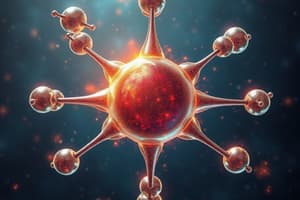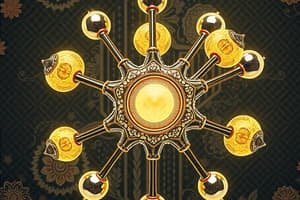Podcast
Questions and Answers
What occurs during ionic bonding?
What occurs during ionic bonding?
- Atoms transfer electrons to form oppositely charged ions. (correct)
- Atoms share electrons equally.
- Electrons are lost without affecting charge.
- Ionic bonds form only between non-metals.
What is the primary factor that causes ions to bond in ionic compounds?
What is the primary factor that causes ions to bond in ionic compounds?
- Electrostatic forces between oppositely charged ions. (correct)
- Electron clouds colliding.
- Magnetic attraction between charged ions.
- The presence of shared electrons.
What type of ions are formed when metals lose electrons?
What type of ions are formed when metals lose electrons?
- Anions, which are negatively charged.
- Molecules, which are neutral.
- Cations, which are negatively charged.
- Cations, which are positively charged. (correct)
In a giant ionic lattice, the arrangement of ions is best described as:
In a giant ionic lattice, the arrangement of ions is best described as:
Which type of model is useful for representing ionic compounds?
Which type of model is useful for representing ionic compounds?
What property is typically associated with ionic compounds due to their strong electrostatic forces?
What property is typically associated with ionic compounds due to their strong electrostatic forces?
Which of the following correctly describes an anion?
Which of the following correctly describes an anion?
What limitation exists in the 3D ball and stick model of ionic compounds?
What limitation exists in the 3D ball and stick model of ionic compounds?
Which groups of elements typically form ions similar to noble gases?
Which groups of elements typically form ions similar to noble gases?
What characteristic of solid ionic crystals contributes to their regular shapes?
What characteristic of solid ionic crystals contributes to their regular shapes?
Flashcards
Ionic Bonding
Ionic Bonding
The bond formed between a metal and a non-metal. Electrons are transferred, forming ions with opposite charges that attract.
Covalent Bonding
Covalent Bonding
Atoms sharing electrons to achieve a full outer shell.
Metallic Bonding
Metallic Bonding
Bonding in metals, where valence electrons are shared by many atoms.
Ion
Ion
Signup and view all the flashcards
Anion
Anion
Signup and view all the flashcards
Cation
Cation
Signup and view all the flashcards
Electrostatic Force
Electrostatic Force
Signup and view all the flashcards
Giant Ionic Lattice
Giant Ionic Lattice
Signup and view all the flashcards
High Melting/Boiling Point (Ionic Compounds)
High Melting/Boiling Point (Ionic Compounds)
Signup and view all the flashcards
Dot-and-cross Diagram
Dot-and-cross Diagram
Signup and view all the flashcards
Study Notes
Atomic Bonding
- Atoms bond to achieve greater stability, gaining a full outer electron shell.
- Three main types of bonding: ionic, covalent, and metallic.
Ionic Bonding
- Occurs when metals and nonmetals react, transferring electrons.
- Forms ions (charged atoms/groups), with opposite charges.
- Electrostatic forces attract the oppositely charged ions, creating the bond.
Covalent Bonding
- Nonmetal atoms share electron pairs.
Metallic Bonding
- Occurs in metals and metal alloys (mixtures of metals).
Ions
- Formed by gaining or losing electrons to achieve a full outer shell.
- Negative ions (anions) gain electrons; positive ions (cations) lose electrons.
- Metals lose electrons, becoming positive ions.
- Non-metals gain electrons, becoming negative ions.
Dot and Cross Diagrams
- Represent electron arrangements in ionic compounds.
- Show electrons as dots and crosses.
- Display ion charges at the top right corner in brackets.
Giant Ionic Lattice
- Regular arrangement of alternating positive and negative ions.
- Strong electrostatic forces hold the lattice together.
- Electrostatic forces act in all directions.
- High melting and boiling points due to these strong forces.
- Solid ionic compounds are called giant ionic lattices.
Representing Ionic Compounds
- 3D ball-and-stick models show ion arrangement, but incorrectly depict bonds and space between ions.
- 3D space-filling models are more accurate, as they show a more densely packed arrangement of ions without gaps.
Studying That Suits You
Use AI to generate personalized quizzes and flashcards to suit your learning preferences.




